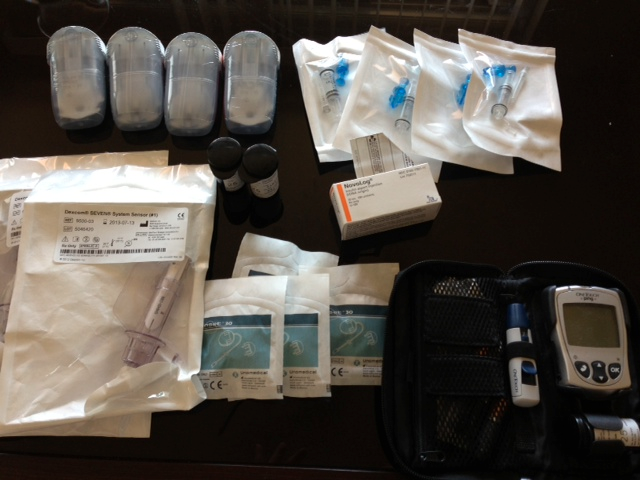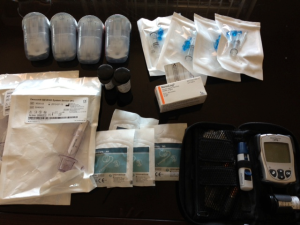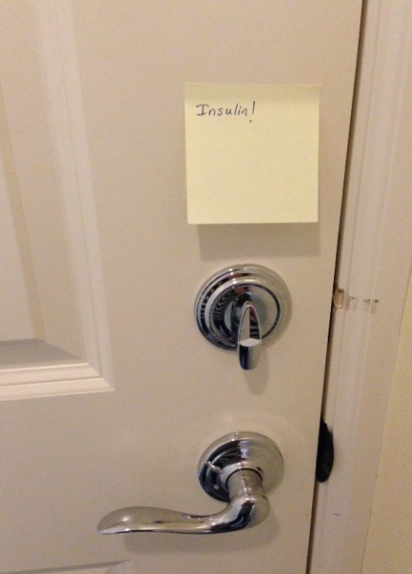Kelsey Guest Post: Traveling with a Chronic Illness

Kelsey is a dear friend who shares our love of travel. In fact, she and her boyfriend rearranged their first luxury award trip to Asia to hit 4 cities in 4 days (trip report to come) based on my recommendations for Singapore and the Thai Airways First Class Lounge in Bangkok.
I was hanging out with them the day before their trip when I found out she had medication that needed refrigeration. I promptly panicked lest some hotel or plane not have a fridge they could use and drove them around the city to find a solution until we finally settled on an insulated lunch cooler. I had no idea what folks would do in her situation and asked her to share her tips:
As much as I love traveling, there are some elements that I would rather do without.  I don’t just mean long security lines or inconsiderate fellow passengers.  I mean the stress and added hassle that comes with traveling with a chronic illness, in my case, type 1 diabetes.
 I’ve had type 1 diabetes since I was 7 years old.  For those who aren’t familiar with type 1 diabetes, I didn’t get it because I ate too much sugar as a child or anything like that.  Type 1 is an immune system malfunction that causes your body to stop producing insulin, a hormone that is necessary to control blood sugar and convert food into energy (there are also 2 other types of diabetes, type 2 and gestational, that have different risk factors and manifest themselves in slightly different ways).  As a result I need to test my blood sugar 5-7 times per day with a finger stick and use an insulin pump to get the insulin I need.
I’ve had type 1 diabetes since I was 7 years old.  For those who aren’t familiar with type 1 diabetes, I didn’t get it because I ate too much sugar as a child or anything like that.  Type 1 is an immune system malfunction that causes your body to stop producing insulin, a hormone that is necessary to control blood sugar and convert food into energy (there are also 2 other types of diabetes, type 2 and gestational, that have different risk factors and manifest themselves in slightly different ways).  As a result I need to test my blood sugar 5-7 times per day with a finger stick and use an insulin pump to get the insulin I need.
Even though I’ve had type 1 for a long time, I still get nervous when I travel just because there is so much I need to remember to pack.  I need my meter to test my blood sugar along with test strips, a lancet, and spare batteries (once I forgot my meter on a short mileage run…that was not fun!).  For my pump I need infusion sites, insulin cartridges, extra insulin, and spare batteries.  I also use a continuous glucose monitor that tracks my blood sugar throughout the day, so I need spare sensors and the charger for the receiver.  Finally, I always carry fruit snacks in case my blood sugar goes too low, so I pack those as well.  That’s a lot to remember!  To make it easier I usually keep a week’s worth of supplies packed in my suitcase at all times and just add/subtract as needed.  I also stash backup supplies in my purses and make myself lots of reminder notes as I’m packing to remember everything!

The trickiest part of all of this isn’t just the packing process.  Insulin needs to be kept cold until it’s used, so I also have to think about how to do that throughout the trip.  I usually wind up putting a post-it on my door so I remember to grab it from the fridge on the way out since I can’t pack it the night before.  On shorter trips I’m usually able to just keep it in a plastic bag to go through security and then get some ice from a lounge or restaurant once I’m airside.  On a longer trip like my recent trip through Australia and Asia I will take an insulated bag and add ice when possible.
On the plane I was able to replenish the ice from the flight attendants, and one Thai Airways flight attendant even gave me some dry ice which worked perfectly!  Once I reach my hotel I put it in the fridge or over the ice bucket (so it doesn’t freeze), once again writing myself lots of notes so I don’t forget it on my way out!

On my 4 cities in 4 days trip, it usually worked out that we had a hotel room as soon as we arrived and were checking out on our way to the airport. On the one time our room wasn’t ready at the Park Hyatt Sydney, they were happy to refrigerate it for me until it was.
Two other things I usually take with me, especially on international trips, are a letter from my doctor explaining that I have diabetes and listing the supplies I use, as well as my prescriptions.  Sometimes I’ll even translate the letter into the appropriate language to make it easier in the case of a language barrier.  Fortunately I’ve never had a problem with my supplies going through security abroad, but it’s always reassuring to know that I could explain my supplies and why they’re essential if needed.
Despite the stress that comes with traveling with a chronic disease, it can be done, and it doesn’t have to overshadow your whole trip!  Planning ahead and packing lots of extras will allow you to put your mind at ease.  Post-it notes and cell phone reminders are your friend, too, especially if you have perishable meds that are at risk of being left in a hotel fridge (in which case you’d definitely want a spare prescription!).

What are your strategies for traveling with special supplies or meds?
—————–
What did you think of this post? Give us a +1 below or leave a comment!
And don’t miss out on any of our adventures and tips. Get instant updates via e-mail or RSS Feed and follow us on twitter and Facebook.
Heels First’s Travel Advice–Sophisticated Travel, Uncomplicated Advice. The travels and tribulations of two frequent flyers jumping into the world of travel, sharing their travel advice. Join Keri and Jeanne as they tackle mileage runs, elite status, and of course–the perfect travel accessories.

Very informative post from Kelsey. Well written, factual,specific suggestions.
I also have to travel with medication that requires to be kept cold (at $900 a shot I cant afford to loose it).
This is what I use
http://www.fridge-to-go.net.au/medicaltravelwallet
I use this product
http://www.fridge-to-go.net.au/medicaltravelwallet
Thank you for this post Kelsey! Very informative.
Thanks for sharing the Fridge-to-Go! Looks like a good product.
Glad folks found my article informative! It’s always good to share tips and ideas!
I am a mother of a Type 1 Diabetic and I’ve made it my mission to make sure there’s nothing off limits to him, especially travel. The only thing I would add to this very well and accurately written article is a Glucogon. Whenever traveling, have one with you because not all airlines have one on board. In addition, make sure the person traveling with you knows how to use it. This is EXTREMELY important because some airline communication interferes with the CGM and I’ve personally witnessed a disaster during a transatlantic flight and saved someone else’s life using my son’s Glucogon. Best of luck Sweet People 😉
Thanks for sharing Kelsey. We never really thought about what all went into the travel plans of a diabetic. Very educational!
Great article! What type of fruit and snacks do you take on your trips?